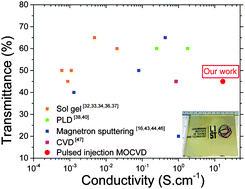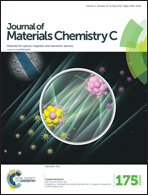Transparent conductive CuCrO2 thin films deposited by pulsed injection metal organic chemical vapor deposition: up-scalable process technology for an improved transparency/conductivity trade-off
Abstract
Metal organic chemical vapor deposition is carefully optimized for the growth of pure CuCrO2 delafossite coatings on glass substrates. The pulsed direct liquid delivery is demonstrated to be an efficient process technology for the controlled supply of the precursor solution in the evaporation chamber, which is shown to be one of the main process parameters to tailor the thin-film properties. We investigated the influence of the precursor concentration ratio Cu(thd)2 (bis[2,2,6,6-tetramethyl-3,5-heptanedionato]copper(II)) and Cr(thd)3 (tris[2,2,6,6-tetramethyl-3,5-heptanedionato]chromium(III)) on the crystal structure, morphology and electrical conductivity, at a reduced temperature of 370 °C. We observe for a low ratio, a pure delafossite phase with a constant Cu-poor/Cr-rich chemical composition, while at a high ratio a mixture of copper oxides and CuCrO2 was found. The as-grown 140 nm-thick pure delafossite films exhibit an exceptional high electrical conductivity for a non-intentionally doped CuCrO2, 17 S cm−1, and a near 50% transparency in the visible spectral range.


 Please wait while we load your content...
Please wait while we load your content...